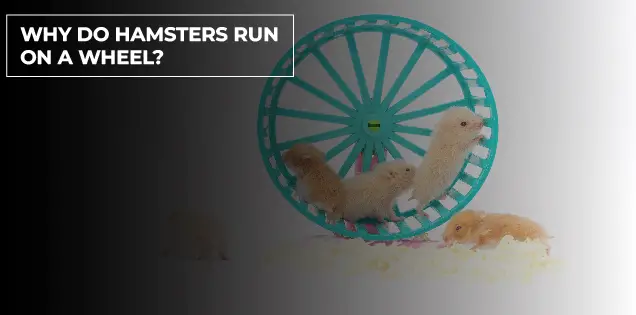So, why do hamsters run on wheels? Hamsters are very important. They are even used for research on infectious diseases. However, you adopted a little marathon runner when you brought home a hamster.
It’s common knowledge that these little animals like the hamster wheel. However, only a few people realize how much training they need until you live with them 24/7.
The good news is that moderate running is great for their health and happiness. So why do hamsters even need wheels to get around?
This article has the answer. So read to know!
Why Do Hamsters Run?

While some believe hamsters run to gain muscle, others suggest that they do it out of boredom or anxiety. For example, hamsters are relatively tiny animals and need regular exercise to maintain good health.
Rolling about on their wheels is a major component of their routine. Running wheels provide a solid running surface for hamsters. Hamsters would spend their days in the wild roaming about in search of food and getting away from predators. They replicate that activity on running wheels.
How Fast Can Hamsters Run?

Some estimates put the hamster’s top speed at six miles per hour. When you consider their stature, that’s a surprising rate of speed. Not only that, but they have no trouble doing this for long periods.
At one point in history, a single hamster could travel 26.2 miles on its hamster wheel in only five days. Most folks these days probably can’t even run five miles weekly. Indeed, this demonstrates how active hamsters can be when provided with hamster wheels.
Why Do Hamsters Run on Wheels?
Here are some reasons:
Due to Their Ancestral History

Let’s consider the hamster’s natural state before it was tamed and turned into a pet, and we’ll have a better idea of why these little rodents like running on wheels so much. Ultimately, every behavior of a domesticated animal has a basis in its wild ancestry.
Since many predators in the wild would not spend their time attempting to make a meal from a hamster, we find them at the bottom of the food chain.
Due to this, hamsters have evolved a wide variety of behaviors like running, which has helped them thrive in the wild. They would have gone extinct long ago if they were that simple to capture.
Hamsters Are Nocturnal Animals

Hamsters are nocturnal creatures that have adapted to the increased likelihood of daytime predators to increase their survival. Instead, they spend the day tucked up in their burrows, emerging only at night to embark on a hunt for sustenance when conditions are more favorable.
But nocturnal hamsters don’t mean they don’t face danger from other animals. Many mammals, including cats and reptiles, are nocturnal predators that would pursue hamsters if they come across them.
Since hamsters are vulnerable to predators at any time of day, the need to flee has become one of their most ingrained behaviors.
The fact that hamsters are so close to the bottom of the food chain in the wild means that they must constantly be on the go to avoid becoming prey.
In the wild or in captivity, hamsters have developed an innate propensity for speed. This explains why, even as pets, hamsters are continually on the go inside their cages.
Thus, a hamster’s natural tendency to run has persisted even after it has gotten tamed as a pet. This is because running is one of the hamster’s fundamental behaviors to ensure its survival.
Running Is a Hobby for Hamsters

Domesticated hamsters, confined to their cages or temporarily released, will always find a way to escape and run. Even if confined, hamsters will find a method to exercise their bodies by running on their wheels.
As hamsters are naturally inclined to run, a hamster wheel satisfies this need. That suggests your hamster prefers running over and playing on its hamster wheel.
The hamster wheel is the one thing that lets it be itself, which is a little rodent that spends pretty much all day running. Hence, hamsters love exercise wheels. Your pet hamster will surely be happy if you buy him an exercise wheel or a hamster ball and put it in the hamster cage.
Whatever the Reason May Be, Wheels Are Beneficial to Hamsters
Any hamster owner or prospective hamster owner should invest in a hamster wheel as soon as possible. Every pet shop will tell you that a hamster wheel is an absolute must-have accessory for your hamster’s cage or habitat.
The hamster will begin using the wheel immediately after you bring it home and place it in its cage. When awake, your hamster will spend most of its time on the wheel running, making it difficult to monitor.
Final Words
Hamsters are very cute. Dwarf hamsters are even cuter. Simple observation reveals that a hamster runs on a running wheel because it likes the activity.
Hamsters are also very fond of hamster balls. It doesn’t matter whether the squeaky wheel has plastic wheels or solid wheels.
Hamsters are tiny rodents found across the grasslands and forests of Central Asia. They need some means of exertion while confined in a tiny area like a cage. And what more efficient means exists than to run on a wheel?
Though six miles per hour may not seem like too much to us, it’s quite a lot for a hamster! They feel most at home while they’re sprinting. They may as well be soaring over the grasslands of their own country.
A hamster only does what comes naturally to him when you watch him running in his wheel the next time. So, recognize the efforts of the underdog.
Also, since you’re already keen on reading about hamsters, check out “Do Hamsters Like Music?“
